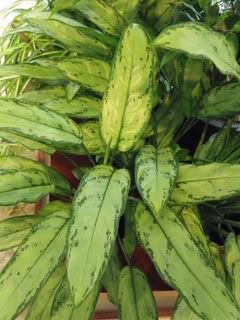
Use a potting mix that retains moisture but drains easily. Cheap potting mix isnít worth the money you save if the plant doesnít thrive in it. Keep the potting mix slightly moist, allowing it to dry out fairly well between waterings. If the soil is dry about an inch down, it is time to water. Fertilize Aglaonemas once a month during active growth with a complete fertilizer.
It is rare for Aglaonemas to have problems with insects. They donít attract pests, although mealy bugs will occasionally take advantage of a neglected plant. Mealy bugs look like small fluffs of cotton and are usually found in crevices and creases of plants: where leaves are connected to the plant or where new leaves are emerging, for instance. If you check the plant over thoroughly before purchasing it is unlikely that you will have pest problems.
Aglaonemas are very easy to propagate. Cuttings can be taken and rooted in water or stuck directly in moist potting mix and covered with plastic wrap to keep the humidity up. Plants can also be divided. This is best done in the spring when the plant is beginning to actively grow and put out new roots. If the plant is already growing new roots it will take to a new pot nicely. Take special care not to over-water the new plants until they have become established.
Aglaonemas are in the Araceae plant family, alongside Elephant Ears, Philodendron and Dumb Cane. This means that they contain calcium oxalate crystals which can cause skin irritation and are extremely painful if eaten. Keep these plants away from nibbling pets and curious children to be safe. Like other Arums, Aglaonemas also flower. They have the typical spadix and spathe flower like the popular Peace Lily. Most Aglaonemas do not have an attractive flower and it can be removed if so desired.


